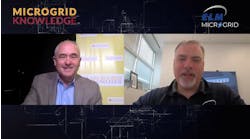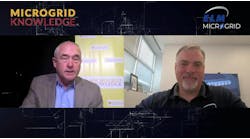Erik Svanholm, vice president, non-wires alternatives for S&C Electric, defines the term ‘non-wires alternatives’ and gives examples of how microgrids can provide these alternatives to traditional investments in wires and the transmission grid during an interview with Microgrid Knowledge’s Elisa Wood at Microgrid 2019.
S&C Electric’s Erik Svanholm kicked off an interview at Microgrid 2019 by offering a concise explanation of non-wires alternatives — a term perhaps unfamiliar to many outside of the energy industry.
Essentially, he explained, it’s a label used by transmission and distribution utilities and their regulators.
“The wires in non-wires alternatives refers to the wires of the transmission and distribution grids,” he said. “So non-wires alternatives are any initiative or investment that a utility or utility customer can make to solve traditional grid problems in non-traditional ways.”
A traditional grid solution would be to expand or replace wires, substations or transformers, while non-wires alternatives can be any solution that meets the same end, but doesn’t involve traditional grid solutions.
Svanholm said this could include the introduction of distributed generation or demand response programs that reduce the load at the problem areas on a grid. Such non-wires alternatives have gained popularity as utilities struggle to reduce local energy loads to increase resiliency and reliability.
Software applications at the utility level that increase efficiency also fall under the umbrella of non-wires alternatives.
“Or it could include microgrids, which are a sophisticated form of using distributed generation in a dynamic way to solve grid challenges,” he added.
Microgrids are applied when a specific area needs added resiliency, power quality and reliability.
And Svanholm pointed out that at Microgrid 2019 in May, attendees heard about a variety of projects in the microgrid space that have been developed to address non-wires issues.
Not all of these projects have to involve a technical solution, he said.
Energy efficiency programs serve as an example: utilities find ways to compensate their customers for operating more efficiently and using less electricity, Svanholm said. Such programs may enable utilities to defer or avoid direct investment and capital expenditures in expanding and increasing the capacity for local areas of the grid.
So — why non-wires alternatives?
Svanholm said it’s all about delivering the electrical system performance customers are expecting. And that challenge is steadily rising for utilities; while on the customer side, their demands for power quality, reliability and resilience are steadily increasing, as well.
“Non-wires alternatives represent a way by which to get the necessary performance faster, better and cheaper perhaps, than the traditional approaches, and that’s what’s driving this development,” he said.
Track microgrid news and trends as they emerge. Subscribe to the free Microgrid Knowledge newsletter.







